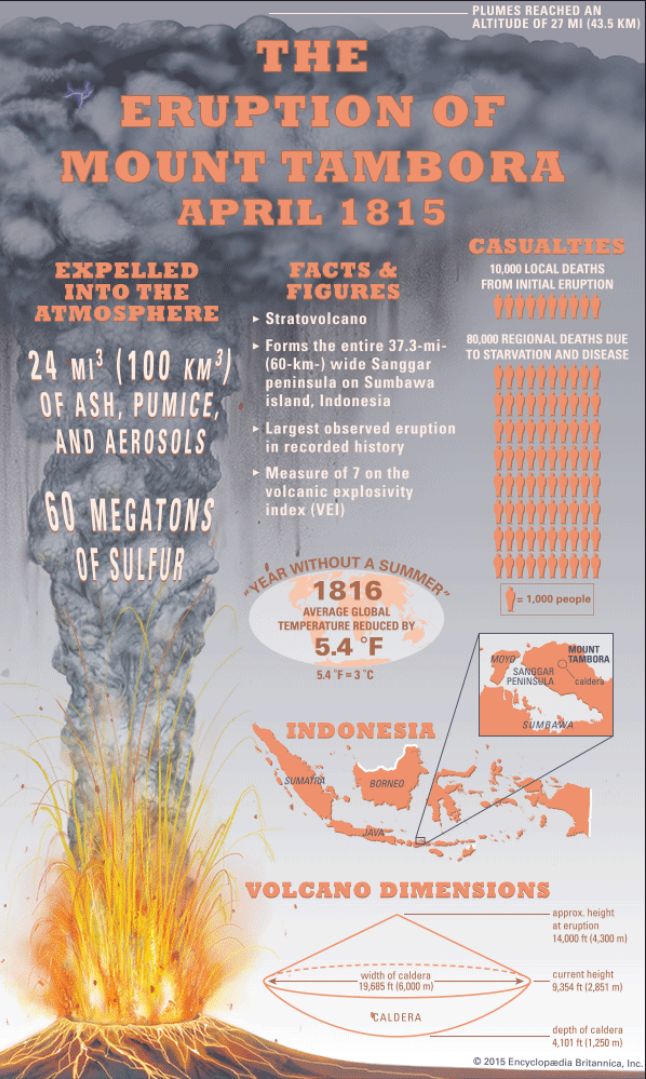
The Wrath of Mt. Tambora
A very poignant phrase that begins this article goes as followed “To be alive in the years 1816-1818, almost anywhere in the world, meant to be hungry.” Even though it was named “A year without a summer.” The duration of the effects of the centralized disaster felt around the world lasted approximately for three years starting in 1815. It was considered a weather crisis. Agriculture failed, nothing was growing from the ground and what did grow was often washed away through terrible flooding throughout many regions. People ate what they found or stayed their hunger by eating things that had no nutritional value, for example, peasants in Yunnan, China would suck on white clay. Imagine sucking on chalk because there was nothing else. It was rough not only ecologically but financially, sociologically, and economically. Despite this there were a few bright spots that would turn out to be the most enduring discoveries and advancements to this day.
Firstly, what caused this 3-year period of darkness? In the time between 1815-1818 the global climate was deteriorating rapidly before bouncing back like it never happened. On April 10, 1815 Mount Tambora volcano erupted on the island of Sambawa in the Dutch East Indies in what is now known as Indonesia. It was the most notable volcano event in recorded history as well as having the largest eruption in the past 10,000 years. It spewed approximately 43 kilometers, that’s 26.7 miles of gases and ash upwards into the stratosphere and had fallout of approximately 1300 kilometer, 807.8 miles out into the distance. The entirety of Indonesia and the East India regions were under cover of darkness. It The eruption created sulfate gases that formed into an aerial dust cloud that created a massive debris fall of 100 cubic kilometers, which is the visual equivalent of 40,000 times as big as The Great Pyramid of Giza. It not only obscured the sun over Indonesia but continued to circle the earth and cause a great disruption over weather patterns and weather precipitation for the next few years. Average temperatures also fell by a margin between 3°F and 6°F degrees. In Indonesia alone, the direct impact caused 90,000 deaths, the highest in volcano related deaths.
Major Changes Bring Major Pains
Mt. Tambora altered history for many people. The 3-year long food crisis was a weakening blow to colonization efforts, giving way to local revolts against western influences, piracy, and slavery. It disrupted the monsoons that created the condition for typhus and cholera which itself spread throughout Bengal in 1817 and further across the entire globe, becoming an epidemic that killed millions. It spread so far due to the massive migrations of people in search for land and food within distant nations. In China There was a revolt against the Qing Dynasty that was the catalyst for the opium trade to begin in Yunnan and later poppy production became a popular marketable venture. In Western Europe many people were displaced from their native homes and or invaded their neighbors in Russian or headed further out to America. This time was not without adventure as there was a huge rush toward the North Pole when it was discovered the ice caps were melting and artic exploration became a distraction for many enterprising people in the nineteenth century. Farmers in North America left for more promising prospects in Ohio, Pennsylvania and the Midwest which became a major agricultural leader for the U.S.A and the Atlantic world. You can imagine the price of staple foods like rice were much higher than what many could afford.

This bleak picture of the period is not without a silver lining. Amidst the homelessness, diseases, famine, death and despair there were political and healthcare reforms happening in Ireland, humanitarian efforts taking place in France where authorities helped maintain the affordability of bread during the food shortages despite the tense relationship between the citizens and those in rulership post Napoleon’s rule, and many others who followed suit in the reforms of those in political powers as they realized and rekindled their responsibility towards those of the lower classes. Although it is the lower classes who took the brunt of the disaster and of whom we do not have sufficient recorded materials to adequately analyze the scale of this three-year event. The upper classes in contrast, left plenty behind for historians to pour over because the upper class was both educated and literate. These records took many forms most often in the romantic literary genre that would describe the atmosphere and the sentiments during that time, often disguised within a story. Other times not disguised at all. Many such stories would bloom from this crisis. One such is in the form of a poem aptly named “Darkness” written by Lord Byron.

Of Poems and Dreams, of Nightmares in Scenes
Lord Byron was an aristocrat and a traveling companion to Mary Shelley and he wrote this poem after experiencing a particularly dark day when on any normal day it should have been sunny outside. The poem is about dreaming of a dream that turns out to be a living nightmare. During such a dream listlessness takes hold of men and they forget themselves and what drives them, spending their time praying for the light to return. Time seems to have been lost in a never-ending cycle, especially when they are hardly able to see the sun in the sky. A desolate time where watchfires were your only source of light and heat in the cold. Anything flammable was used to keep the fires going. Furnishings were fuel as well as parts of your home. Whole cities were smoldering for warmer days. There was no resolution in sight for those who survived the aftermath of the volcano. Regular food was scarce, and people took to eating once considered wild game such as birds and snakes alike. I did find the part about snakes quite interesting and it reminded me a bit of Paradise Lost.
“/…/the wild birds shriek’d
And, terrified, did flutter on the ground,
And flap their useless wings; the wildest brutes
Came tame and tremulous; and vipers crawl’d
And twin’d themselves among the multitude,
Hissing, but stingless—they were slain for food.”
The snakes twining itself around the helpless flightless birds who are unable to fly are both “punished” by a hungry human. This part stood out during my second time reading the poem. Byron also wrote of war that ceased. Who has the vigor to fight on an empty stomach? It was a moment where all earth was one in thought and direction driven by the single purpose of hunger. Where there was no master over beasts and the beasts became the masters out of sheer survival instinct. Dogs were turning on their masters, famine, a different kind of beast, was consuming the flesh of the people and those that escaped its emaciating grasp would fall dead in their tracks. Dread sails forth from the following words.
“/…/The world was void,
The populous and the powerful was a lump,
Seasonless, herbless, treeless, manless, lifeless—
A lump of death—a chaos of hard clay.”
Although I find this next line to be the most striking on several levels.
“Darkness had no need
Of aid from them—She was the Universe.”
Not only does it refer to the climate crisis, but it can also refer to the fact that the universe is actually a deep expense of black and just is. There’s no sense in fighting the universe it will continue to be and doesn’t need help to do what it is there to do. The universe could also refer to the Earth itself as the self-regulating entity it is and all they could do was wait it out in the hopes that things went back to how they were which they did. It’s almost like the Earth had major cold for 3 years and was congested and stuck in the bed of space suffering from hot flashes and the chills that took a long time to heal.
- What would you do if we were in a three-year food shortage?
- Are we adequately prepared to handle such a disaster today?
- What stood out to you while reading “Darkness”?
Work Cited
Wood, Gillen D’Arcy. “1816, The Year without a Summer.” BRANCH: Britain, Representation and Nineteenth-Century History. Ed. Dino Franco Felluga. Extension of Romanticism and Victorianism on the Net. Web. March 06, 2018.
To Learn more about what happened with Mt. Tambora do visit the Smithsonian Magazine.


